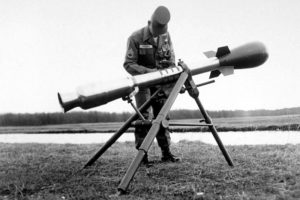September 12, 2018
Jeffrey Lewis
The following is an excerpt from Foreign Policy.

U.S. developed M-388 Davy Crockett nuclear weapon mounted to a recoilless rifle on a tripod, shown here at the Aberdeen Proving Ground in Maryland in March 1961. (Department of Defense)
When Dwight D. Eisenhower took the oath of office as the 34th president of the United States in 1953, the total U.S. nuclear stockpile was approaching 1,000. When Ike left, eight years later, that number had grown to around 20,000—with further increases programmed in. Those weapons included one of the strangest creations of the Cold War: an atomic bazooka, putting nuclear destruction in the hands of as few as two soldiers.
For the U.S. military planners of the 1950s, nuclear weapons were not merely strategic assets to deter conflict but munitions ready for use in the event of hostilities. Eisenhower looked to nuclear weapons as a cheaper alternative to conventional troops at a time when U.S. forces were dangerously, and expensively, overstretched.
Soon after taking office, for example, the Eisenhower administration decided it would use nuclear weapons in Korea if armistice negotiations broke down. Officials announced in 1954 that the United States might respond to conventional aggression anywhere with massive nuclear retaliation. The Eisenhower administration even attempted, in 1957, to reorganize the U.S. Army to better survive on a nuclear battlefield.
Eisenhower put it plainly in his memoirs: “My feeling was then, and still remains, that it would be impossible for the United States to maintain the military commitments which it now sustains around the world (without turning into a garrison state) did we not possess atomic weapons and the will to use them when necessary.”
Continue reading at Foreign Policy.
